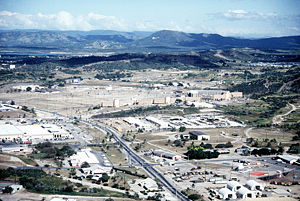Naval Station Guantanamo Bay: Difference between revisions
imported>Howard C. Berkowitz (More specific language; layout) |
imported>Chris Day No edit summary |
||
| Line 1: | Line 1: | ||
{{subpages}} | {{subpages}} | ||
{{ | {{Image|Guantanamo Bay Navy Exchange and BEQ.jpg||300px|Naval Station Guantanamo Bay, circa 1995.}} | ||
{{Image|Guantanamo Naval Base with the Bay in the background.jpg||300px|Naval Station Guantanamo Bay with the Bay in the background, circa 2007.}} | |||
The [[United States]] is entitled, by treaty, to maintain '''Naval Station Guantanamo Bay''' on a 20 square kilometer parcel of land on the Southern coast of [[Cuba]]. The Station historically was used for coaling and other logistics, but has been used as a facility for the involuntary detention of various categories of people, from Haitian refugees to persons accused of [[terrorism]]. It has also been used as a forward base for naval patrols in the Caribbean. | The [[United States]] is entitled, by treaty, to maintain '''Naval Station Guantanamo Bay''' on a 20 square kilometer parcel of land on the Southern coast of [[Cuba]]. The Station historically was used for coaling and other logistics, but has been used as a facility for the involuntary detention of various categories of people, from Haitian refugees to persons accused of [[terrorism]]. It has also been used as a forward base for naval patrols in the Caribbean. | ||
Revision as of 22:36, 6 December 2008
The United States is entitled, by treaty, to maintain Naval Station Guantanamo Bay on a 20 square kilometer parcel of land on the Southern coast of Cuba. The Station historically was used for coaling and other logistics, but has been used as a facility for the involuntary detention of various categories of people, from Haitian refugees to persons accused of terrorism. It has also been used as a forward base for naval patrols in the Caribbean.
History
The United Statest seized Cuba, Puerto Rico, Guam, and the Philippines from Spain, during the Spanish American War.
Treaty
When the USA allowed Cuba to become independent they signed a treaty with the new Government giving it a lease on the site.[1][2] The treaty allows the USA to use it as a Naval Base and Coaling Station, in return for rent of $4,000 per year. When Fidel Castro took power, fifty years ago, to show its opposition to the treaty, the Cuban Government stopped cashing the USA's rent checks.
Uses
Cuban Missile Crisis
Intelligence and surveillance
Internment facility
During the later decades of the 20th Century the USA used the station to detain refugees from Cuba, Haiti and the Dominican Republic.
On January 11th, 2002 the USA opened Camp X-Ray, the first of several camps in the complex of Guantanamo detention camps that hold individuals that the George W. Bush Administration, without a general judicial or prisoner of war determination, deemed necessary to detain in the war on terror.[3]
References
- ↑ Agreement Between the United States and Cuba for the Lease of Lands for Coaling and Naval stations. The Avalon project, Yale Law School (February 23, 1903). Retrieved on 2007-0.
- ↑ . The treaty was updated in 1934. Treaty Between the United States of America and Cuba. The Avalon project, Yale Law School (May 29, 1934). Retrieved on 2007-06-20.
- ↑ U.S. Shifts Policy on Geneva Conventions Bowing to Justices, Administration Says It Will Apply Treaties to Terror Suspects A01. Washington Post (2006-07-12).

